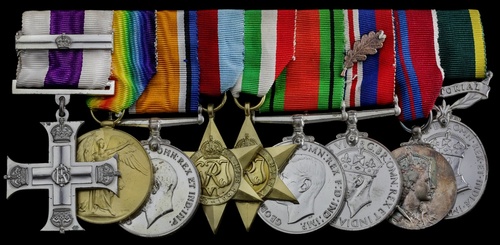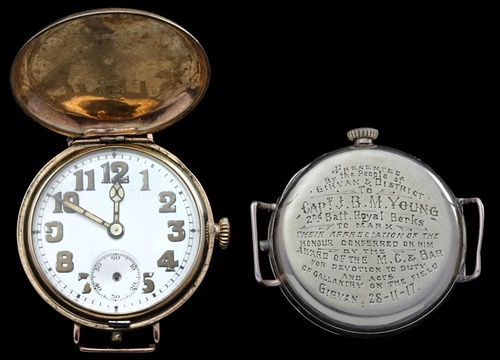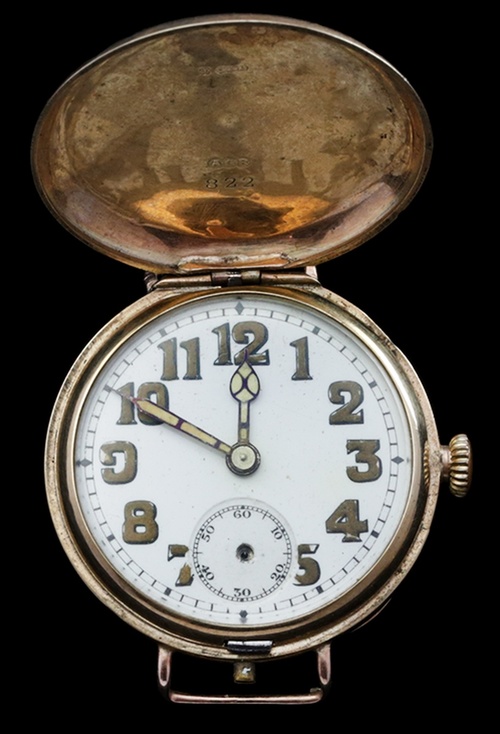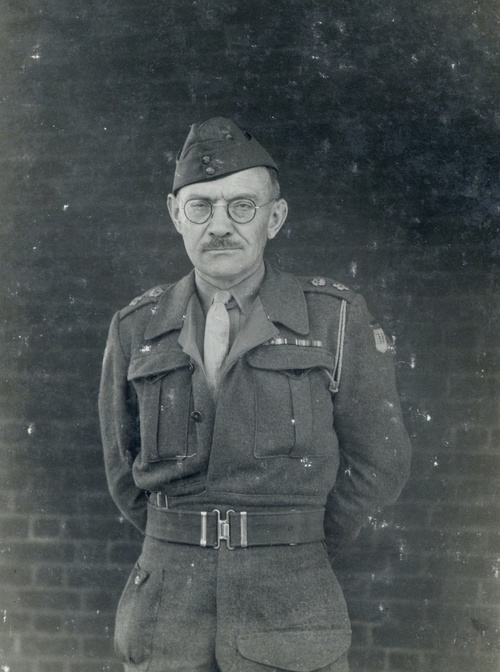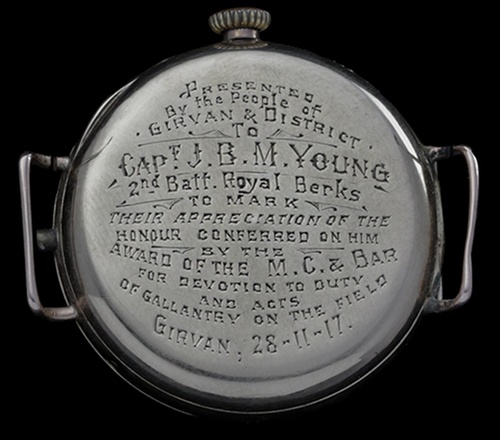Auction: 19003 - Orders, Decorations and Medals
Lot: 310E
Sold by Order of a Direct Descendant
A very fine Western Front M.C. and Bar group of nine awarded to Lieutenant-Colonel J. B. M. Young, Royal Artillery, late Royal Berkshire Regiment and Royal Sussex Regiment, who was wounded and decorated during a vicious night trench raid, and was later wounded for a second occasion on the opening day of the Battle of Langemarck
Military Cross, G.V.R., and Second Award Bar, the reverse engraved 'J. B. M. Young. Royal Berkshire Regt. 11.7.17 & 16.8.17'; British War and Victory Medals (Capt. J. B. M. Young.); 1939-45 Star; Italy Star; Defence and War Medals 1939-45 with M.I.D. oakleaf; Coronation 1953; Territorial Efficiency Medal , G.VI.R. (Major. J. B. M. Young. M.C. R.A.), the fourth and fifth gilded, mounted as worn, minor contact marks, otherwise good very fine (9)
M.C. London Gazette 17 September 1917:
'During a raid on enemy trenches he led his men with great dash and determination, killing one of the enemy as he was on the point of throwing a bomb. On being wounded he continued to exercise control, and directed the retirement exceptionally well.'
Bar to M.C. London Gazette 26 September 1917.
James Barclay Murdoch Young was born on 9 December 1898 at Glendoune House, Girvan, Ayrshire, the son of John George Kirkpatrick Young. Having joined the Royal Sussex Regiment as a Cadet, he was commissioned Temporary 2nd Lieutenant on 26 September 1916 and was attached to the 2nd Battalion, Royal Berkshire Regiment. He served in France from 24 April 1917 and was awarded the Military Cross for gallantry and devotion to duty during a significant raid on German trenches near Hooge on the night of 10-11 July 1917 as part of the Third Battle of Ypres. The Battalion War Diary and contemporary accounts later published in The Biscuit Boys describe the scene:
'At 00:45hrs on 11 July 1917, 168 men of all ranks, comprising 'B' Company and 1 platoon of 'C' Company of the 2nd Battalion, Royal Berkshire Regiment, formed up at Kingsway, an assembly point on the British front line. Their aim was to raid the German front line trenches, deploy blocks and hopefully gather prisoners - in what had hitherto been one of the quietest sectors of the front, where the 1st Battalion, Worcestershire Regiment, and the 2nd Battalion, East Lancashire Regiment, had only recorded two O.R.'s killed and seventeen wounded from 4 April-9 July 1917.
At 01:00hrs a 15 minute British artillery barrage lifted and the men emerged from the trenches, 50% of whom had never been in action before and therefore lacked experience. Owing to the gloom and dust flung up by British shellfire, sections were inclined to bunch together at the start, but managed to reassemble at proper intervals by the time the German front-line trench was reached. Pressing on at a pace, the second line was reached at Zero plus 14, and 'all things considered, [the attack] went very well.'
However, the failure to ensure a thorough 'mopping up' of all enemy dugouts led to a tense few minutes:
'It was very difficult, owing to the darkness, to recognise the entrances to dugouts, the consequence being that after our line passed over, the enemy emerged and brought a machine-gun into action.'
The gun was knocked out by Sergeant Sturgess who was later decorated with the Distinguished Conduct Medal for his bravery at a critical moment. The Germans however, continued to put up a determined resistance and in consequence only 1 prisoner was taken, this being by Private Bawden:
'With reference to this, one German fired at Private H. E. Bawden, the bullet grazing the latter's arm. Private Bawden knowing how essential identification was, showed great self-restraint in not killing the man, who immediately put his hands up after firing.'
Bawden was awarded a parchment certificate for his efforts, but in another case two Germans offered to surrender and then threw bombs. They were killed. Due to the ferocity of the exchange and the all-pervasive darkness, 'it was estimated that 30 Germans were killed from hand to hand encounters' (ibid).
Having reached their objectives and bombed all the dugouts and shelters in Hooge Crater, the men began to withdraw. Upon the signal, all remaining stoke mortar bombs were thrown into enemy dugouts and the men returned to the British trenches. According to conservative estimates, the 44 minute attack resulted in German casualties of between 70 and 80 men, but the British themselves recorded 3 officers wounded, 3 other ranks killed and a further 35 wounded or missing.
Having survived the encounter unscathed, Young and his men re-joined the Battalion at Ouderdom and spent the next two weeks training at Rebecques and Tournehem, following which they marched to Dominion Camp and on to Swan Chateau. Their brief respite did not last long however, for on the night on 31 July 1917 they faced a heavy barrage of 5.9" and 8" shells in the line between Westhoek and Chateau Wood. As the men were relieved by the Loyal North Lancashire Regiment, the incessant rain and mud meant that all ranks were very tired and wet by the time they reached the comparative safety of Pioneer Camp. The majority of the Battalion trudged through the murk that night, but a few stragglers turned up during the following morning. Although the Battalion was not seriously engaged, losses were heavy including Lieutenant-Colonel Haig, D.S.O., wounded, 15 other ranks killed, 109 wounded and 20 missing in action.
On 16 August 1917 the 2nd Battalion, Berkshire Regiment, were tasked with capturing the road running south-east from Zonnebeke along the Glasgow Spur, a second road running parallel to it just east of the village, and on past the Iron Cross Redoubt. Formed up on tapes, at 04.45hrs the advance commenced and the Battalion began to move forward beyond the marshy bed of the Hannebeke. The Commanding Officer, Major Arthur Alan Hanbury-Sparrow, was now powerless to control events. It was all in the hands of the Company Commanders such as Young:
'For ten minutes or a quarter of an hour you lay in a shell hole amidst this cataract of steel. The Niagara of Vulcan! Drum fire! Field guns clattering like a rackety xylophone! Treble of Vickers! Bass of heavies. All merged into this roaring deluge in which the acrid air throbbed, pulsed and vibrated, and in which men shook and shuddered. Flashes lost in the greying dawn! Cascades of leaping earth, clods and shards. A tension of nerves strained taut to ecstasy. Prisoners running, hands up, through the crashing shells, bleeding, as wounded Germans did, like stuck pigs, a bayonet man as escort' (The recollections of Major, later Lieutenant-Colonel A. A. Hanbury-Sparrow, D.S.O. and Bar, M.C., refer).
After this the Battalion was under a heavy machine-gun enfilading fire from Nonne Boschen and Polygon Woods. The greater part of Iron Cross redoubt and the defences to the north of it were captured with 50 prisoners taken, but by 0800hrs the losses were telling. At 1030hrs the Germans launched a devastating counter attack which left just 4 officers and 100 men of the 2nd Battalion able to continue the battle. The Commanding Officer did not mince the enormity of the situation:
'It had come. You were for it. The end couldn't be far away now. Well, you had had a long run for your money. Resigned to death? Yes, but not so much as to prevent you loathing the thought.'
As the Germans flung reserves into their counter-attack, the remaining men of the Berkshire Regiment began to run low on ammunition. By 1500hrs there were only sixty men of the Berkshires and 20 men of the Lincolnshire Regiment left to form a defensive flank and cover a retirement which had to be made, but at a desperate juncture, the enemy desisted from pressing on and the survivors were relieved by the 2nd Battalion, Northamptonshire Regiment. According to Hanbury-Sparrow, 'the men had done magnificently', but the casualties were appalling; 2 officers had been killed and 7 wounded, including Captain J. B. M. Young. A further 24 other ranks had been killed with 223 wounded and 120 missing. For his actions on this day, Young was awarded a Bar to the M.C.
Following the cessation of hostilities, Young determined to enrol at the University of Oxford where he graduated with a Bachelor of Arts degree. He then studied at the University of Edinburgh, graduating LL.B. and was subsequently admitted to the Faculty of Advocates in December 1925 (The Scotsman, refers), being promoted Clerk of Faculty in 1937 (The Aberdeen Press and Journal, refers).
Young was commissioned Captain in the Royal Artillery on 31 May 1939 and witnessed further service overseas during the Second World War. Promoted Lieutenant-Colonel at the war's end, he returned home to Greenbank House, Clarkston, and was appointed King's Counsel to His Majesty in Scotland in December 1947. Young later became Sheriff-Substitute of Renfrew and Argyll at Paisley in 1950 and died on 12 December 1957 at Edinburgh.
Sold with extensive copied research and the following contemporary items and ephemera:
(i)
A fine 9ct. gold wristwatch, with engraved monogram to obverse 'J. B. M. Y.', and inscribed to reverse 'Presented by the people of Girvan & District to Capt. J. B. M. Young, 2nd. Batt. Royal Berks, to mark their appreciation of the honour conferred on him by the award of the M.C. & Bar for devotion to duty and acts of gallantry on the field, Girvan, 28-11-17.', minor dent to front of case but in overall good condition, lacking strap, movement appears to function but lacks second hand.
(ii)
Silver identity disc and bracelet, engraved 'J. B. M. Young. Pres. The Royal Berkshire Regt.'; a second engraved in a similar fashion, likely a souvenir.
(iii)
British Military Identity Document, issued 2 December 1943, containing a passport photograph of the recipient; three further photographs of Young, two being in military uniform with medal riband visible.
Subject to 20% VAT on Buyer’s Premium. For more information please view Terms and Conditions for Buyers.
Sold for
£3,500
Starting price
£950

